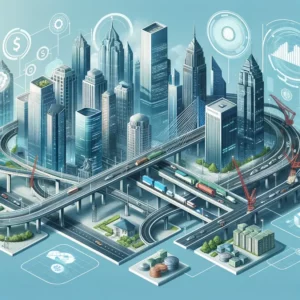Here we’ll examine some of the best infrastructure funds.
Infrastructure funds are available in a range of risk and return profiles, from safer options to riskier ones. They are able to make debt and stock investments.
Even while the market as a whole is typically less volatile than the infrastructure sector, it’s crucial to remember that these funds still have risks.
If you are looking to invest as an expat or high-net-worth individual, which is what I specialize in, you can email me (advice@adamfayed.com) or WhatsApp (+44-7393-450-837).
It makes sense to seek guidance or advice as infrastructure funds might not be regarded as low-risk investments.
Infrastructure Funds Meaning
What are infrastructure funds?

Plans for investments known as infrastructure funds focus mostly on buildings and utilities that provide communities with essential services. Given the high cost and duration of infrastructure asset development, these are often long-term investments.
Because infrastructure comprises inflation-linked assets and offers steady income distributions, it has grown more prevalent in diversified portfolios. Assets ranging from buildings like hospitals and schools to highways, trains, and bridges can all be included in infrastructure funds investments.
Best Infrastructure Funds
Below is an infrastructure funds list that includes options you might want to look more into.
First Sentier Global Listed Infrastructure Fund
Through investments in globally listed infrastructure firms, the fund seeks to generate income as well as some growth. The fund was formerly called the First State Global Listed Infrastructure fund.
The fund, which is owned by the international asset management organization First Sentier Investors, is committed to providing customers with premium, long-term investment solutions.
Global infrastructure, such as ports and bridges, is the primary focus of First Sentier Global Listed Infrastructure fund’s investments.
They favor making investments in physical infrastructure properties with powerful price and access barriers. They contend that independent boards, adequate leverage, and open regulations, among other things, are necessary for infrastructure to realize its full potential.
The fund includes investments in oil and gas pipelines and storage as part of a varied approach that balances the overall energy mix, even though it does prioritize hydrogen, renewable energy, and decarbonizing mobility.
M&G Global Listed Infrastructure Fund

This infrastructure fund extends beyond its traditional boundaries. Economic, social, and evolving infrastructure comprise the three primary segments of the industry that M&G Global Listed Infrastructure fund seeks to balance in terms of growth and income.
This indicates that it makes investments in various areas, including toll highways, utilities, healthcare, education, and civil construction. Modern infrastructure such as data centers, payment businesses, cell towers, and royalties are also included.
Businesses who profit greatly from coal and nuclear energy, or who violate the UN Global Compact, are not invested in by this fund.
Originally established in 1931, M&G Investments was a division of Prudential plc before becoming public on the London Stock Exchange. Although it also makes real estate and multi-asset investments, its primary focus is on fixed interest and stocks.
Schroder Digital Infrastructure Fund
The goal of this infrastructure fund is to profit from the transition to a digital economy and the rising need for related infrastructure. It makes investments in roughly 40 stocks in established and emerging economies globally. The fund’s strategy heavily weighs green considerations, and it excludes companies with subpar ESG performance.
Fiber optic cables, data centers, and macro towers are the three primary areas of focus for Schroder Digital Infrastructure fund. About 300 companies and REITs make up the fund’s investable universe, which is determined by a data-driven methodology.
Established in 1804, Schroders has operations in more than 25 nations and is traded on the London Stock Exchange. It makes investments in equities, bonds, multi-asset, and alternative asset classes.
VT Gravis UK Infrastructure Income

The primary focus of VT Gravis fund is investing in trusts that manage a variety of UK infrastructure projects, including roads, trains, and solar energy. Besides offering exposure to a less hazardous and higher-yielding segment of the UK economy, quarterly distributions are made toward its annual income target of 5%.
This fund, which was unveiled in January 2016, is well diversified and offers a great chance to participate in the expanding UK infrastructure market. Given the current challenging income environment, its substantial return appeals to income-focused investors. It also provides some inflation hedge.
As the first fund with an open-ended structure, VT Gravis UK Infrastructure Income allowed investors to participate in the infrastructure sector of UK stocks. In addition to equities, bonds, and REITs, it also invests in a variety of assets.
The majority of the fund, around two thirds, is allocated to investment trusts associated with various forms of infrastructure like private, public, and renewable energy.
Note that the fund chooses equities without much ESG regard.
The 2008-founded Gravis is a knowledgeable advisory firm for infrastructure.
Pros and cons of infrastructure funds
Benefits of investing in infrastructure funds
- Infrastructure assets tend to generate income in ways that increase in tandem with price surges, providing a degree of cost containment.
- Adding infrastructure funds to your financial portfolio can help you diversify your risk.
- Infrastructure funds enable investments in social services, utilities, transportation, and communication—things that communities truly need. Typically, these are quite secure investments.
- Despite being less risky than some other investment categories, infrastructure can jump in value over time as more people require these vital services.
Risks of infrastructure investment funds
- Infrastructure funds’ performance might be contingent upon the performance of particular stocks and sectors.
- If you need money urgently, it might not be possible to sell some infrastructure funds—especially private ones.
- Investing in closed-ended options, such as investment businesses, may present challenges if their prices are high relative to their true worth.
- Politics carries a risk because most projects receive government funding.
- A rapid increase in interest rates may not benefit the fund as much.
Pained by financial indecision?

Adam is an internationally recognised author on financial matters with over 830million answer views on Quora, a widely sold book on Amazon, and a contributor on Forbes.



